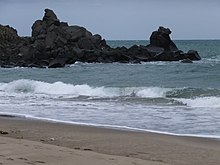Fuguijiao
Fugui Jiao ( Chinese 富貴 角 , Pinyin Fùguìjiǎo , Japanese ふ う き か く , Fūki Kaku, English: Cape Fugui) is the northernmost point of Taiwan . It is located in Fugui Jiao Yuan (富貴 角 园; Cape Fugui Park) in the Laomei district (老 梅里, Lǎoméi Lǐ ) in the Shimen district of New Taipei .
Surname
Fùguì jiăo is the Pinyin transcription of the standard Chinese pronunciation of the Chinese characters "富貴 角". These characters literally mean “Empire & Noble Cape ”. However, this is actually the Chinese transcription of the Dutch hoek ("hook" = cape, headland) in the local Hokkien pronunciation Hù-kùi .
In the 19th century the cape was known as Foki ( Qing Dynasty ). Under Japanese rule , the name Fūki Kaku (the Japanese pronunciation of the same characters) was common. In the Tongyong Pinyin inscription it is written Fuguei .
geography
Fuguijiao is the northernmost point of Taiwan and forms the western end of Laomei Bay, which stretches east to Jianzilu Bi near Shimen Dong . On the west coast of the peninsula there is still the fishing village Fujicun (富 基 村) with the fishing port (富 基 漁港, Fuji yugang). Further to the west, the Linshanbi peninsula (麟 山 鼻 Lín shān bí) closes the next bay (白 沙灣). In the north of the peninsula only the settlement Fenglin (楓林) with the Fuguijiao Park and the Fuguijiao lighthouse (富貴 角 燈塔, Fuguijiao Dengta) is located.
Under the Japanese name "Fuki Kaku" the cape forms one of the landmarks for the definition of the International Hydrographic Organization (IHO) for the East China Sea (IHO 1953 §50) and the South China Sea (IHO 1953 §49). The not yet ratified draft of the 4th edition of Limits of Oceans and Seas changes the name to the pinyin form "Fugui" and moves the border of the South China Sea from Fugui to Taiwan's southern tip Eluanbi .
Fuguijiao is also considered part of the northern boundary of the Formosa Strait .
traffic
The cape is located at kilometer 26 of the Danjin Gonglu (淡 金 公路 , 北部 X 海 Beibu lianghai Gong lu, "2nd Northern Coastal Road"). However, landslides often occur, like after heavy rains in June 2017.
Fuguijiao Park
The Fuguijiao Park puts the landscape under nature protection. On the beach there are impressive Windkanter (wind-shaped rocks) and the landscape is characterized by lush subtropical vegetation. There is a circular walk from Fuji Port (富 基 渔港, Fùjī Yúgǎng) to Laomei, as well as a brick labyrinth ( Laomei Maze ). Old military buildings of the Taiwanese army have been set up as studios for local artists. The Shimen District Kite Festival is held in the park in September and October .
history
In 1896 the Japanese administration erected a building at the end of a submarine cable . This building was destroyed in World War II. The Fuguijiao lighthouse was built by the Taiwanese administration in 1949. The current black and white octagonal tower was built in 1962. The lighthouse was opened to the public in 2015, but visits are only possible on weekends as it has an active radar station from the Air Force of the Republic of China .
gallery
Sunset over Formosa Street in 2015
Individual evidence
- ↑ a b c d e Fugui Cape. New Taipei City, Tourism and Travel Department (NTC) tour.ntpc.gov.tw 2019.
- ^ Public sign, supplemented by Caltonhill 2012.
- ^ Art. "Formosa." In: Encyclopaedia Britannica. 9th ed., Vol.IX, New York: Charles Scribner's Sons 1879: 415.
- ↑ Calton Hill 2012th
- ^ Art. "Formosa." In: Encyclopaedia Britannica. 9th ed., Vol.IX, New York: Charles Scribner's Sons 1879: 415.
- ↑ NTC 2019. "Fugui Cape Lighthouse"
- ↑ geonames.org .
- ↑ a b IHO 1986 Ch. 7.3 .
- ↑ a b IHO 1986 Ch. 7.2 .
- ↑ IHO 1986 Ch. 6.1
- ↑ NTC 2019 Due to recent heavy rain ...
- ↑ a b c d NTC 2019 "Fuguijiao Park" .
- ↑ NTC 2019 Laomei Maze ; NTC 2019 Awesome Positive Energy! A Guide to New Taipei City's 12 Attractions to Improve Your Luck .
- ^ A b c Taiwan's Century-Old Fugueijiao Lighthouse Opened to the Public. Want China Times, http://www.wantchinatimes.com September 29, 2015 [1]
literature
- Formosa , In: Encyclopaedia Britannica , 9th ed., Vol. IX, New York: Charles Scribner's Sons, 1879: 415-17.
- S-23: Limits of Oceans and Seas (PDF) (3rd ed.) , Monaco: International Hydrographic Organization, 1953. S-23: Limits of Oceans and Seas. International Hydrographic Organization (IHO).
- S-23: Limits of Oceans and Seas (4th (draft) ed.) , Monaco: International Hydrographic Organization, 1986.
- Official site. New Taipei City, Tourism and Travel Department (NTC) tour.ntpc.gov.tw 2019.
- Mark Caltonhill: 富貴 角 Fuguei Cape, New Taipei City In: From Takow to Kaohsiung: Exploring Taiwan's History, Culture, and Languages through Its Place Names. taiwanplacenames.blogspot.com May 2012.







